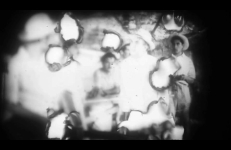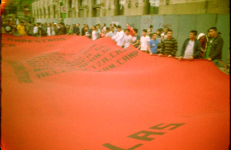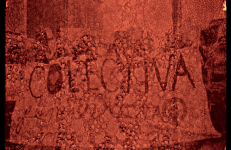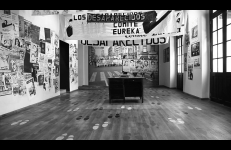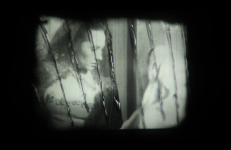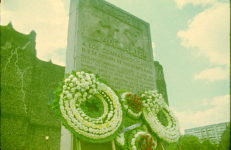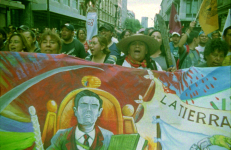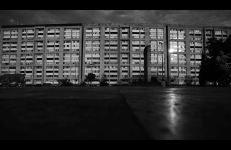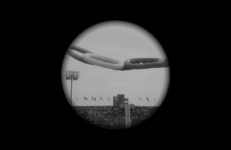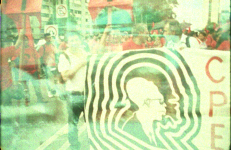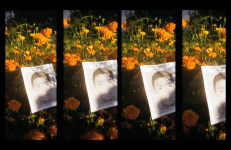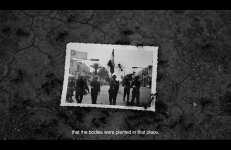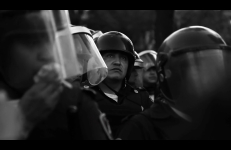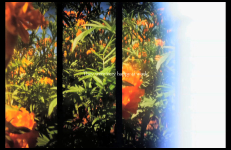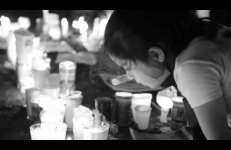An audiovisual experience of the current Mexican war.
Colectivo Los Ingrávidos: Political Cinema
A political composition on natural resistance. These images are an expiring breath in danger of extinction. These images become extinguished, consumed: a drop, a pure intensity which only appears when falling. In the presence of the image these audiovisual crowds become an affected body, assaulted by entropy. A face exhausted and reanimated by the continuous sound trance that traverses the battlefield. Faces for an eye that would not need to see.
In Dry Blood (Sagre Seca), various historical moments of political activism in Mexico are superimposed and corroded on the emulsion of expired film. Footage from the International Women's Day in 2017 is coupled with the recording of a powerful speech about the gruesome aftermath of the 2006 civil unrest in San Salvador Atenco.
Mother’s Day in Mexico is considered one of the most important family holidays of the year. Thousands of mothers have nothing to celebrate. They are the mothers of victims of forced disappearances. Mothers and relatives of the disappeared participated in the "March of National Dignity. Mothers searching for their Sons, Daughters and Justice."
A suspension of events, they coexist and claim a kind of common temporality. A topological and architectural immersion.
A woman raises her voice and gives a painful and endless speech that with time becomes even more overwhelming, because her words are heartbreaking and permanent impressions in the collective memory, stabbing with words an old Mexican film, a celluloid that tears apart until its disappearance.
This title is also available on the compilation What Was Always Yours and Never Lost.
A political composition on natural resistance. These images are an expiring breath in danger of extinction. These images become extinguished, consumed: a drop, a pure intensity which only appears when falling. In the presence of the image these audiovisual crowds become an affected body, assaulted by entropy. A face exhausted and reanimated by the continuous sound trance that traverses the battlefield. Faces for an eye that would not need to see.
Notes for a DejaVu is a paramnesic experience of the images where Jonas Mekas still lives and we can hear him comment on the memory of an imaginary trip to Mexico. This film is shot with an expired 16mm celluloid during a popular protest. This is a movie that remembers. This is a political movie.
A voice for which an event impossible to internalize remains distant. An event that in its distance does not cease to make the narration of something that should not take place anywhere foreign. The military massacre against unarmed students in 1968.
1968 was the opening of the Summer Olympics in Mexico City, ten days after the massacre of students and civilians by military and police on October 2 in the "Plaza de las Tres Culturas, Tlatelolco."
A political composition on natural resistance. These images are an expiring breath in danger of extinction. These images become extinguished, consumed: a drop, a pure intensity which only appears when falling. In the presence of the image these audiovisual crowds become an affected body, assaulted by entropy. A face exhausted and reanimated by the continuous sound trance that traverses the battlefield. Faces for an eye that would not need to see.
The planting of the "cempasuchil" for the celebrations of the "Day of Death" is one of the last jobs that the Ayotzianapa normal students did before they were brutally disappeared, with small Lomokino 35mm cameras, which we had to compose-hit several times since they are manufactured to be disposable, we record the harvest of the season, with the purpose of impregnating in the fragility of the chemical canvas: the earth, no longer that of the common graves but that other earth that gives light to the work of our fellow Normalistas.
Radio reports analyze staged photographs we do not see, showing the victims of a mass murder committed by Mexican soldiers. The politicization of the film accounts for the duality between framing and mis-framing, and also shows the overflowing character of a process of transit.
A brief dialogue between Marianne Renoir and Pierrot and a short description-reading from ‘Pierrot le fou’ about Diego Velázquez – these intersect with a visual moment to constitute the outline of a perception and the occurrence of the idea of ‘el pueblo,’ of a meeting.
The film suggests a link between three political figures from the history of Mexican resistance: the Soldadera (woman guerrilla fighter), the Zapatista (member of the Zapatista Army of National Liberation), and the Normalista (students from the Ayotzinapa Normal School).
An elegy to the popular demands against ominous social and political events in the recent Mexico.




